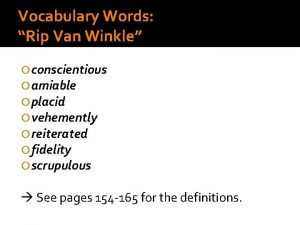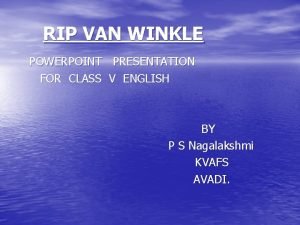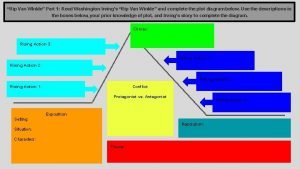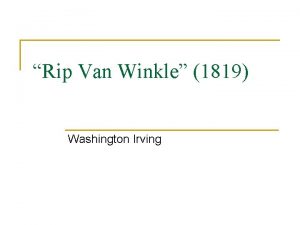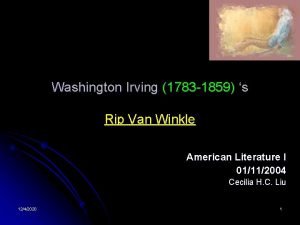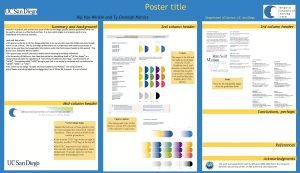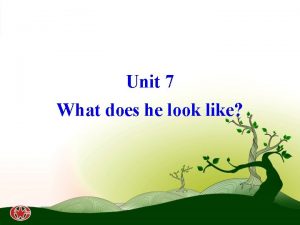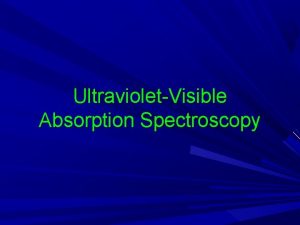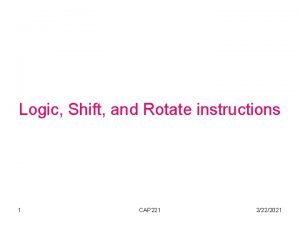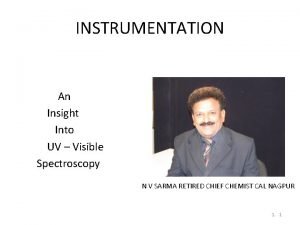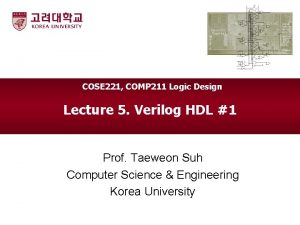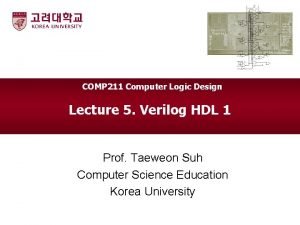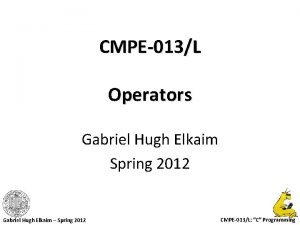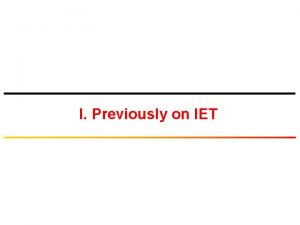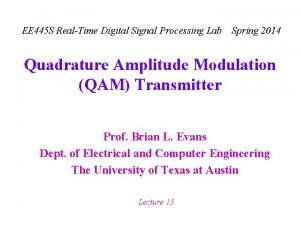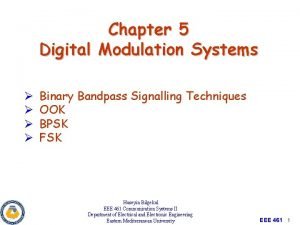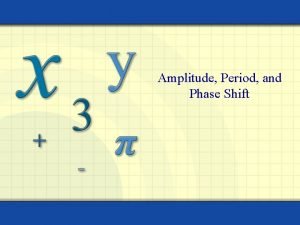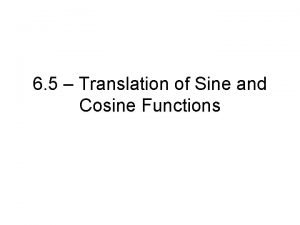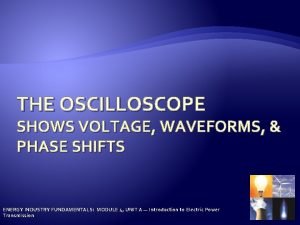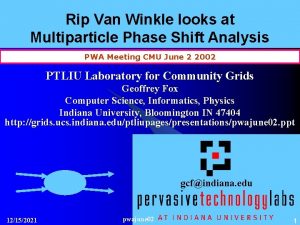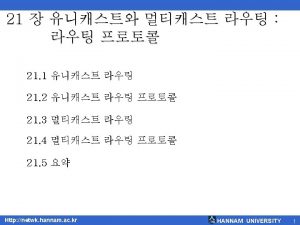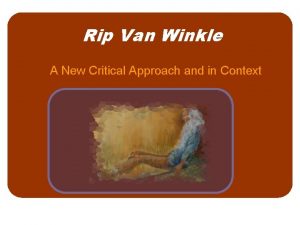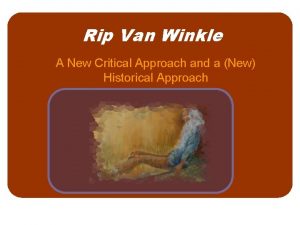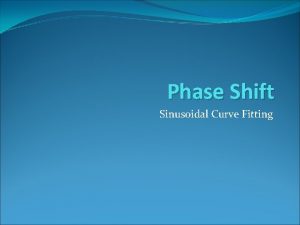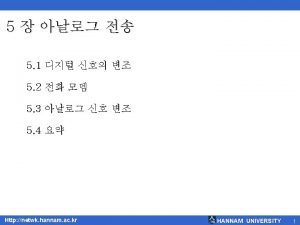Rip Van Winkle looks at Multiparticle Phase Shift


























- Slides: 26

Rip Van Winkle looks at Multiparticle Phase Shift Analysis PWA Meeting CMU June 2 2002 PTLIU Laboratory for Community Grids Geoffrey Fox Computer Science, Informatics, Physics Indiana University, Bloomington IN 47404 http: //grids. ucs. indiana. edu/ptliupages/presentations/pwajune 02. ppt gcf@indiana. edu 3/3/2021 pwajune 02 1

When I left ……. . E 350 0 X E 260 200 Ge. V hp “infinite” Progress in Jets but not so much in understanding low p. T hadron-hadron collisions pwajune 02 3/3/2021 0 X 0 -t 0 X 0 2

Apologies l l l For errors and for not giving enough credit I have not studied since area of science for 22 years and even when I worked full time in high energy physics, I studied production amplitudes and not partial wave analysis I read many papers which suggested that open issues of past are still open and many of these could impact PWA I haven’t even adjusted to change in names of particles …. . Think of me as a rather inaccurate conscience from the past 3/3/2021 pwajune 02 3

Issues in Partial Wave Analysis l l Goal: Extract clear evidence for resonances; determine masses, widths and their decay modes; compare with theoretical models; especially in areas that extend understanding of quark model (exotics, glueballs) Approach: – e+ e- : very clean but limited statistics and sensitivity to structure (not all mesons/baryons of interest can be produced in reactions that can be detected analysed) – Hadron-hadron and photon-hadron (low p. T): potentially (but not so far in practice) very high statistics but substantial obfuscatory effects that could (in some cases) be impractical to disentangle (final state interactions, direct versus exchange reactions …) 3/3/2021 pwajune 02 4

Hadron(Photon)-Hadron Reactions l l l 2 2: Obviously very clean but limited to a few obvious reactions such as γ N π N, π N etc. – Analyses here are with good enough statistics largely uncontroversial at partial wave analysis level. Interpretation in terms of resonances may be impossible due to small couplings etc. 2 3 or more: π N π π N, p p annihilation etc. where full final state partial wave analyzed – Large increase in degrees of freedom – Effective ways of dealing with 3 particle states usually require resonance assumptions which have intrinsic uncertainties – Some effects (like π exchange) not studied in π N 2 (state to be analyzed) plus one or more other particles – in particular peripheral production of states to be analyzed – Further set of problems due to confusion of “other processes” linking full final state and of lack of clearly defined amplitude 3/3/2021 pwajune 02 5

t l l Some Truths I s according to RVW Amplitudes exhibit many features for which there is no clear formalism that expresses in an integrated fashion Analytic Structure as in S matrix with poles and cuts – Poles correspond to particles and resonances – Cuts to multiple exchanges (box and more complex diagrams) – Need to look at all channels to get full analytic structure l Unitarity as a well understood (but difficult in multiparticle case to implement) constraint in every direct sub-channel – Constraint only strong at low channel energy when one or a few possible intermediate states 3/3/2021 pwajune 02 6

Direct Channel Constraints s l Impose unitarity in s for 2 particle PWA 1 s 123 s 12 s 23 2 s 13 l l 3/3/2021 pwajune 02 Impose unitarity in s 12 s 13 s 23 for 3 particle PWA This is “final state interactions” Unitarity in s 123 not a strong constraint 7

Some RVW Truths II l l l Spin Formalism well understood both for full, decay, and Regge exchange amplitudes – Extremely complex Analytic structure of amplitudes well understood for tchannel (Jackson-Gottfried), s-channel frame helicity and transversity amplitudes – Transversity amplitudes have nice selection rules and invariance under rotations – But poor analyticity structure s-channel frame has particularly good analyticity and well understood “zero” structure at t=0 3/3/2021 pwajune 02 8

Some RVW Truths III l l l t(u)-channel exchanges are “classically” the forces that create the s-channel particles Thus it is not trivially “wrong” that same effect (e. g. diffractively produced A 1) can be “explained from direct or cross channel point of view Veneziano model illustrates this in a fashion that is not quantitatively useful 1 3 1 t 2 3/3/2021 4 u 4 2 pwajune 02 3 9

Peripheral Production l Choose cases where peripheral production strong to avoid larger backgrounds than necessary (inevitable) Internal Exchanges 1 s 12 s 23 2 s 13 3 Production Exchange 3/3/2021 pwajune 02 10

Backgrounds I l Many Backgrounds such as “false peripheral signal” Internal Exchanges 1 Another Exchange 3/3/2021 3 2 pwajune 02 Of course if original “production exchange” inside bottom vertex, then this is “just a multiperipheral diagram” and OK 11

Multiperipheral Diagrams l As in Deck model 1 π Another Exchange 3 π Pomeron etc. p 3/3/2021 π π 2 Production Exchange π p pwajune 02 12

Backgrounds II l Rescattering in lots of channels Internal Exchanges 1 2 This one is some sort of Regge cut but not in “full s channel” 3 Production Exchange 3/3/2021 pwajune 02 13

Some RVW Truths IV l l l Quark Model and QCD can give useful predictions as to both particle spectra and branching ratios Selection rules are always good including those reflecting conservation of quark content Regge theory has a few spectacular successes in describing high energy scattering – Linear and A 2 exchange degenerate trajectories with =0 dip for and spin flip nucleon coupling – Pomeron and exchange are only phenomenologically understood – Details like polarization not understood – Absorption (cuts) not convincing l Difficult to believe results sensitive to uncertainties in these “partial” theories – Some exchanges are known to be big or small and this is always seen – Small high energy amplitude (e. g. backward scattering) must translate to (amplitude) cancellation at low energies ( A 0 interference) 3/3/2021 pwajune 02 14

Partial Wave Analysis Formalism l l Can use Density Matrix or Amplitude – Amplitude enforces rank and positivity conditions on density matrix – Amplitude has in principle at least well defined analyticity properties Factorization (Regge exchange) suggests low rank but we know this fails for exchange due to conspirator 1 Beam 2 Reggeon Exchange 3/3/2021 3 pwajune 02 15

Amplitudes? l l l Can think in terms of Beam + Reggeon 1 + 2 + 3 amplitudes but this already shows these are not “simple” amplitudes – Amplitudes depend on t ( mass 2 of Reggeon) and helicities of Beam, 1 2 and 3. – Multiple exchanges and cuts also increase number of amplitudes (even though not much quantitative evidence for them) Safest to use amplitude model for cases where exchanges are strong – and exchange degenerate A 2 families are best – Pomeron probably OK but we don’t understand as well – with adjustment for conspirator (different naturality but structure determined at t=0) – For example B 1 exchange ( exchange degenerate partner) isn’t very good Will photon beams prove harder as two helicities unless excellent polarization data? 3/3/2021 pwajune 02 16

Factorization Useful? l l In days gone by, we got essentially identical dynamics from π- p π0 n ; π- p π0 inclusive ; π- p π0 plus any neutral So at least in cases where clear Reggeon exchange involved, doesn’t really matter if “target vertex” reaction clean 1 2 3 Production Exchange 3/3/2021 pwajune 02 Add anything you like at bottom vertex 17

Conspiracy l Problems with double spin flip amplitudes p l n OK with helicity 0 but naïve factorizable exchange vanishes when helicity 1 – not seen experimentally p n vertex vanishes at t=0 as spin flip=0 Interesting to compare with production at target vertexas p does not vanish at t=0 3/3/2021 pwajune 02 18

Fitting the Data I l Assume unlimited computer time, disk space and network bandwidth – At least no significant constraints from these issues l Not clear to me what fitting techniques used – Typically Physics ahead of Computer Science in area of multiparameter fitting – Maybe “unlimited computer time” and better management of results could lead to new approaches such as: l “Ensemble Fitting techniques” (e. g. genetic algorithms) which explore parameter space more completely than traditional (Taylor expansion) least squares methods – Probably not particularly to find “new solutions” but rather to better depict error band of a given “solution” – e. g. “histograms” would automatically display ensemble and not a single “best fit” – we have plenty of memory/disk space to store 3/3/2021 pwajune 02 19

Fitting the Data II l Data mining – Develop a suite of analysis programs that look for and catalog anomalies in experiment, theory or discrepancy between them – Link to data management system to more systematically categorize different fits l Multi-dimensional Visualization (human data-mining) – We still seem to be using histograms – Perhaps we could develop some better “standard” displays supported as a Web Services with portlet interfaces (to betray my current expertise) – Printed version of Phys. Rev. Letter still has histogram playing role of “icon”. There is also a URI (Universal Resource Identifier) which is active in on-line version and gives the “new nifty display” 3/3/2021 pwajune 02 20

Some lessons I l l l All confusing effects exist and no fundamental (correct) way to remove. So one should: – Minimize effect of the hard (insoluble) problems such as “particles from wrong vertex”, “unestimatable exchange effects” sensitive to slope of unclear Regge trajectories, absorption etc. Note many of effects (exchanges) are intrinsically MORE important in multiparticle case than in relatively well studied π N Try to estimate impact of uncertainties from each effect on results – Need systematic very high statistic studies of relatively clean cases where spectroscopy may be uninteresting but one can examine uncertainties – Possibilities are A 1 A 2 A 3 B 1 peripherally produced and even π N ππN 3/3/2021 pwajune 02 21

Some lessons II l l l Theory failed to provide convincing parameterizable amplitudes one could use to fit/explain data Theory provided some quantitative constraints (pi pole, unitarity, kinematics …), many qualitative truths which overlap and whose effect can be estimated with errors from 10 to 100% 20 years ago, Rip van Winkle dozed off as not clear how to make progress Now we must take a factor of 100 or so more data to tackle problem phenomenologically First step is to clarify technique Next step is to use technique to do new physics 3/3/2021 pwajune 02 22

Effects to Include I l l Spin Formalism: Need BOTH – Amplitude Parameterization – is this practical if (potential) rank high as with photon beams or non factorizing exchanges? – Density Matrix Formalism – how does this cope with explicit contributions, analyticity etc. – Transversity versus helicity formalism needs to be investigated – trade-off of analyticity versus selection rules Unitarity: use current approaches building in twoparticle unitarity (final state interactions) 3/3/2021 pwajune 02 23

Effects to Include II l l l Exchange Contributions: Identify allowed (by normal Regge phenomenology) exchanges and catalog where expected to be large due to coupling constants and/or values of (t, u) Use usual duality type arguments to identify related s. AB t u exchanges i. e. where you might expect the direct and crossed descriptions to be related Develop models for exchange contributions using simple phenomenological Regge theory but have little hope this is very reliable except for Pomeron, A 2 etc. exchanges and even these won’t be so good as to be used at low direct channel energies – Identify all exchange contributions and expect these to be reliable (with “conspirator) near t=0 but unreliable away from there -- as a Regge pole problematic 3/3/2021 pwajune 02 24

Effects to Include III l Cutkosky style Accelerated Convergence is certainly sound but possibly easier to explicitly include high partial waves rather than choose an expansion that maximizes convergence – Certainly examine exchanges and ask if partial waves larger than those includes are important (in amplitude). If so include – Could also choose Cutkosky style expansion functions l Dispersion Relations and other Analyticity – In an amplitude model, it is useful to examine “spin dependent” kinematic zeroes and the duality style cancellations – Present data and fits in a way to display effect (e. g. fixed u cross sections for reactions with no u channel exchanges) – check qualitatively reasonable 3/3/2021 pwajune 02 25

What else we can do? l Exploit modern computing technology for – More reliable optimization methods – Management of Data before and after analysis l Gri. Phyn and PPDG like efforts will address a lot of base technology for data handling before analysis l Management of Analysis – Computation and Data – open issue – Powerful multi-dimensional visualization techniques and – Data mining to discover anomalies in data and/or fits and/or discrepancies between fits and data l Need to design and build such an environment? 3/3/2021 pwajune 02 26
 Pedantic diction
Pedantic diction Washington irving romanticism
Washington irving romanticism Washington irving ppt
Washington irving ppt Plot diagram of rip van winkle
Plot diagram of rip van winkle Rip van winkle allegory
Rip van winkle allegory Rip van winkle essay
Rip van winkle essay Rip van winkle nature
Rip van winkle nature Rip van winkle climax
Rip van winkle climax Rip van winkle poster
Rip van winkle poster What does he look like?
What does he look like? What does he look like
What does he look like Kim van winkle
Kim van winkle Selection rule for electronic transition
Selection rule for electronic transition Molecular absorption
Molecular absorption Difference between arithmetic shift and logical shift
Difference between arithmetic shift and logical shift Bathochromic shift and hypsochromic shift
Bathochromic shift and hypsochromic shift Difference between arithmetic shift and logical shift
Difference between arithmetic shift and logical shift Difference between arithmetic shift and logical shift
Difference between arithmetic shift and logical shift Difference between arithmetic shift and logical shift
Difference between arithmetic shift and logical shift Difference between arithmetic shift and logical shift
Difference between arithmetic shift and logical shift Horizontal
Horizontal Phase shift keying
Phase shift keying Qam transmitter
Qam transmitter Binary phase shift keying
Binary phase shift keying Find amplitude, period, and phase shift y=4sin(x)
Find amplitude, period, and phase shift y=4sin(x) Horizontal phase shift
Horizontal phase shift Phase shift oscilloscope
Phase shift oscilloscope
